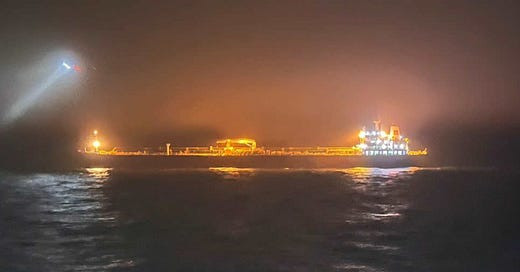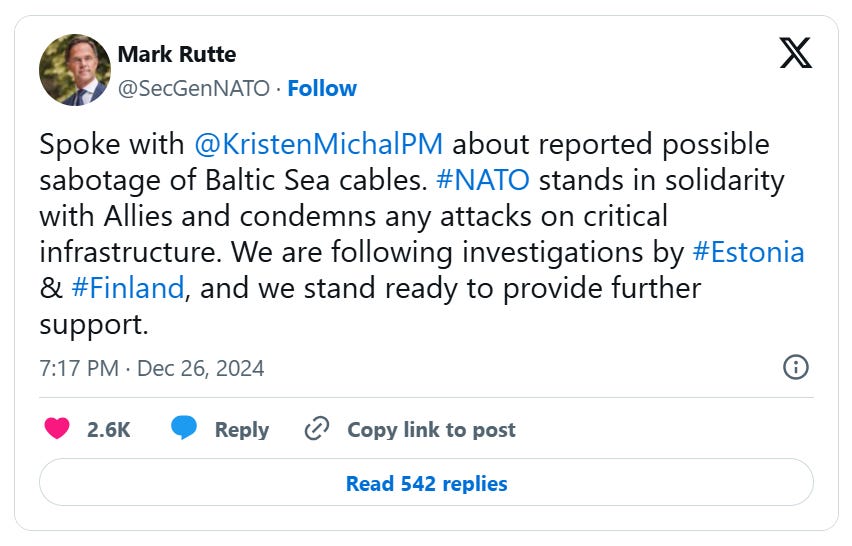Finland Arrests Russian Shadow Ship
Oil tanker caught red-handed in an act of sabotage against cables on the seabed between Finland and Estonia. The ship is confirmed to belong to Russian shadow fleet used for circumvention of sanctions
Christmas Day noontime, the seabed power cables connecting Finland and Estonia experienced an anomaly that caused one of them to malfunction. There is currently no electricity flowing in the EstLink 2 power cable. According to Finnish authorities, the tanker Eagle S is suspected of having inflicted damage to the cables with its anchor.
Eagle S is flagged in the Cook Islands, self-governing territory of New Zealand, but was confirmed by Finnish customs officials as a suspected part of Russia's shadow fleet of fuel tankers and cargo vessels that state-run companies are using to circumvent sanctions.
The fleet is made up of ageing vessels with obscure ownership, acquired to evade the West's economic controls over the war against Ukraine and operating without Western-regulated insurance.
Finnish police is investigating the incident as an act of gross vandalism. The national public service broadcaster YLE is covering the situation and reports about the damage to the electrical cable as well as interruption of data traffic in four data communications cables that were damaged at the same time.
By now, it is difficult to ignore that something intentional and coordinated is going on, with the pointer firmly indicating Russia as the only likely culprit.
Eagle 2 in Finnish territorial waters on Thursday night. Photo: Finnish Police
Caught red-handed
The police took possession of the vessel shortly after the incident, and it is now in Finnish waters. The Border Guard asked the Eagle S to raise the anchor, but only the anchor chain rose to the surface. In the case of Yi Peng 3, photos of the outside of the vessel showed that the ‘horns’ of the anchor had been twisted, apparently as a result of friction against the seabed or bottom rocks.
In one of several earlier incidents (which are likely to now be recognized as act of sabotage, as well) on 8 October 2023, in the Gulf of Finland, the Chinese container ship Newnew Polar Bear lost its anchor in what at the time was seen as intentional damage to the gas pipeline Balticconnecor. The anchor was later retrieved by the Finnish authorities and identified as belonging to the Chinese ship.
A series of underwater explosions ruptured the Nord Stream pipelines that carried Russian gas to Europe in September 2022, but the cause of the blasts is as yet not attributed to any actor, but Russia is one of the suspects. Many others have been mentioned though, including Ukraine, USA and shadowy terrorist groups.
Further consequences of the act of sabotage
Police are investigating the Christmas Day incident as a case of aggravated vandalism. According to customs, the ship belongs to the Russian shadow fleet and is also involved in evading sanctions.
The power and communications situation in Finland and Estonia were not immediately turning critical, but utility and supply companies warned that supply becomes more vulnerable over time, until the damages are repaired.
Estonia’s government has held extraordinary meetings to analyze the situation. Writes the state public service media ERR:
The Estonian Navy and NATO allies will start to more actively monitor critical undersea infrastructure after the EstLink 2 outage, Prime Minister Kristen Michal (Reform) said on Thursday.
"Consultations within NATO, with allies in the Nordic countries, in the Baltic countries, with the leaders of the European Union, are already under way and, if necessary, we can escalate Article 4 from this peacetime round of consultations. We are in the consultation phase at the moment, and we will certainly do so together with the Finns," he said.
Under Article 4 of NATO's founding treaty, members can bring any issue of concern, especially related to the security of a member country, to the table for discussion within the North Atlantic Council.
Since the Alliance's creation in 1949, Article 4 has been invoked seven times.
NATO has offered help to Estonia and Finland –
The bottom line
We are now beyond the point where it is possible to ignore or explain away that the acts of sabotage against underwater infrastructure in the Baltic Sea are deliberate and orchestrated. By the sheer number of them and because of the circumstances, it must be ruled out that these are just accidents.
The Norwegian expert Tormod Heier, professor of military strategy and operations, says to the Finnish newspaper Hufvudstadsbladet:
There is reason to assume that this is organized by Russia. It fits into a pattern where Russian hybrid threats against NATO countries are taking on a more physical dimension. There are more and more sabotage actions against critical infrastructure of great importance to the West, he says.
If this develops into a more prominent hybrid warfare strategy, it could lead to a larger legitimacy crisis. Residents of northern Europe are already struggling with price increases for electricity, food and transport, and cable breaks make it difficult to provide good and safe services.
– In Russian eyes, this is an attractive and risk-free way to contribute to a form of social destabilization and political fragmentation, as it benefits parties that do not necessarily want to spend money on supporting Ukraine year after year.
But there is also the possibility that hybrid attacks will backfire on Russia and lead to more cohesion within NATO countries, as everyone feels vulnerable and rallies behind each other.






The solution to the Russian ‘shadow fleet’ is the same as the solution to Houthi and Somali pirates: armed merchant vessels and Letters of Marque and Reprisal. As the song says:
‘Come with me to Barbary
We’ll ply there up and down
Not quite exactly
In the service of the crown “
Could one or more of these incidents be considered an act of war?